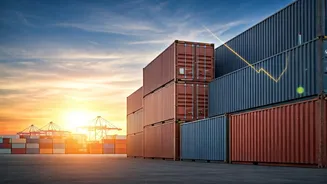The Export Downturn Unveiled
From May through September 2025, India's exports to the United States faced a substantial reduction. The decrease amounted to 37.5%, a figure that merits
careful consideration. This decline presents an important shift in the trade relationship between the two nations and highlights the complex nature of international commerce. Such drastic changes can be influenced by various aspects, encompassing economic climates, shifts in demand, and alterations in trade regulations. Understanding the precise details of this export reduction is vital for policymakers, businesses, and anybody involved with the Indian economy. Analyzing the underlying reasons provides vital insights, allowing for informed choices and strategic adaptations. This drop could have wide-reaching effects, influencing employment rates, industrial development, and India's overall economic trajectory. This drop in exports necessitates a comprehensive analysis to identify the key elements driving this trend and evaluate its long-term effects. The downturn during these months is more than just a statistical blip; it is an indication of potential challenges and prospects within the global trade landscape.
Reasons Behind the Dip
Several factors likely contributed to the 37.5% decrease in Indian exports to the United States from May to September 2025. One significant influence may have been the fluctuating global economic conditions. Economic downturns in either India or the US, or even worldwide, can impact consumer spending and business investments, leading to reduced demand for exported goods. Furthermore, variations in exchange rates could have influenced the affordability of Indian products for US consumers, potentially discouraging imports. Trade regulations and policies between the two countries could have played a role. New tariffs, import duties, or other trade barriers could have made it more expensive or difficult for Indian businesses to access the US market. The competitiveness of the Indian products compared to those from other nations is another crucial element. If other countries offer similar goods at lower prices or more favorable terms, US importers might choose alternative sources. It is important to also analyze the specific sectors experiencing the most significant drops. This would provide valuable insights into the products and industries facing the biggest challenges, allowing for targeted measures to support those sectors.
Sectoral Impact Analysis
The 37.5% reduction in exports would not have affected all sectors equally. Certain industries likely experienced greater impacts than others. For example, sectors like textiles, pharmaceuticals, and engineering goods are important contributors to India's export portfolio to the United States. A fall in demand or an increase in competition within these sectors would have had a noticeable effect on overall export figures. Detailed data, which includes sector-specific export values before and after this period, is vital for a clear analysis. It would highlight the sectors that were hit the hardest and give clues about the underlying reasons for the decline. Furthermore, pinpointing the sectors that faced the biggest challenges enables the government and business leaders to focus their resources on the most pressing issues. This sector-by-sector examination reveals the vulnerability and resilience of different areas of India's export economy. The insights from such an analysis could lead to tailored solutions that include promotional activities, improved product quality, and exploring new markets. In addition to examining sector-specific performance, it is also important to consider the trade partners in the US for each Indian sector to understand which regions have felt the most impact.
Economic Implications Explored
The 37.5% export reduction between May and September 2025 had far-reaching financial repercussions for India. A decline in exports leads to a decrease in revenue for Indian businesses and potential job losses within affected sectors. Reduced export earnings can affect the balance of payments, which is the record of transactions between a country and the rest of the world. A higher trade deficit, if the import levels stay the same, may cause concerns about the stability of the currency and the general state of the economy. The drop in exports affects the overall economic growth of India. Exports often function as a key engine for growth, and a significant fall can lead to a slowdown in GDP expansion. Understanding these financial impacts is vital for creating effective policy responses. Government interventions, like offering financial help to struggling sectors or implementing new trade-promoting policies, are crucial. Additionally, a clear understanding of the ramifications allows for informed decision-making by businesses, allowing them to adapt their strategies and seek opportunities for growth. This economic analysis helps to highlight the importance of export diversity and the need for strengthening India's trade connections with different countries.
Future Outlook and Recovery
The ability to predict the future and the recovery from the 37.5% export downturn hinges on a number of elements. The overall health of the US and global economies is a key determinant. A return to economic growth in the US and throughout the world will naturally boost demand for Indian exports. Changes in trade policies and regulations between India and the United States will play a vital role. Any adjustments that simplify trade or decrease trade barriers will aid in the recovery process. The initiatives taken by both Indian businesses and the government will influence the trajectory. Companies can adapt by diversifying products, finding new markets, and boosting competitiveness. The government can support export-oriented industries with financial help, infrastructure upgrades, and trade facilitation measures. Keeping a close eye on market dynamics, consumer trends, and economic indicators is essential. Constant monitoring will help in identifying new challenges and prospects, and in adjusting the recovery strategies. The goal is to get back to sustainable and balanced export growth, reinforcing India's position in the global market. Furthermore, exploring opportunities to enhance trade relationships with other countries can help mitigate risks associated with over-reliance on a single market.
















